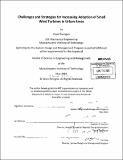| dc.contributor.advisor | Stephen R. Connors. | en_US |
| dc.contributor.author | Ferrigno, Kevin J. (Kevin James) | en_US |
| dc.contributor.other | System Design and Management Program. | en_US |
| dc.date.accessioned | 2010-10-12T18:53:39Z | |
| dc.date.available | 2010-10-12T18:53:39Z | |
| dc.date.issued | 2010 | en_US |
| dc.identifier.uri | http://hdl.handle.net/1721.1/59240 | |
| dc.description | Thesis (S.M. in System Design and Management)--Massachusetts Institute of Technology, Engineering Systems Division, System Design and Management Program, June 2010. | en_US |
| dc.description | "May 2010." Cataloged from PDF version of thesis. | en_US |
| dc.description | Includes bibliographical references (p. 77-80). | en_US |
| dc.description.abstract | A student group at MIT in cooperation with the MIT Department of Facilities is currently working to install a Skystream 3.7 wind turbine on MIT's campus. This has raised several questions about how to best develop small wind projects in urban environments. The best wind resources in the country exist in relatively remote locations and require large investments in electricity transmission infrastructure to be effectively utilized. In the meantime, several large and small projects have been developed in the Boston area. The urban environment presents many challenges to development including the interaction of urban buildings with wind flow, concerns from neighbors and government over the aesthetics and safety of turbines that are installed near human populations, environmental effects including wildlife, noise, and shadows. There are also many opportunities including the ability to use net metering, little or no transmission infrastructure costs, and the ability to build on existing wind resource data and project assessments to develop a large number of installations. This document presents an overview of how the challenges of small wind turbine development in urban, suburban, and rural neighborhoods are currently being addressed by research in new and improved technology for turbines and siting, business strategies of existing companies, financing, and government policy. It looks at the strategy options available to businesses involved development of small wind turbines and evaluates the relative strengths and weaknesses of these strategies in a rapidly changing marketplace. | en_US |
| dc.description.statementofresponsibility | by Kevin Ferrigno. | en_US |
| dc.format.extent | 80 p. | en_US |
| dc.language.iso | eng | en_US |
| dc.publisher | Massachusetts Institute of Technology | en_US |
| dc.rights | M.I.T. theses are protected by
copyright. They may be viewed from this source for any purpose, but
reproduction or distribution in any format is prohibited without written
permission. See provided URL for inquiries about permission. | en_US |
| dc.rights.uri | http://dspace.mit.edu/handle/1721.1/7582 | en_US |
| dc.subject | Engineering Systems Division. | en_US |
| dc.subject | System Design and Management Program. | en_US |
| dc.title | Challenges and strategies for increasing adoption of small wind turbines in urban areas | en_US |
| dc.type | Thesis | en_US |
| dc.description.degree | S.M.in System Design and Management | en_US |
| dc.contributor.department | System Design and Management Program. | en_US |
| dc.contributor.department | Massachusetts Institute of Technology. Engineering Systems Division | |
| dc.identifier.oclc | 666503208 | en_US |
